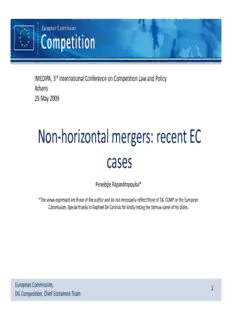
recent EC cases PDF
Preview recent EC cases
IMEDIPA, 3rd International Conference on Competition Law and Policy Athens 2299 MMaayy 22000099 NNoonn‐hhoorriizzoonnttaall mmeerrggeerrss:: rreecceenntt EECC cases Penelope Papandropoulos* *The views expressed are those of the author and do not necessarily reflect those of DG COMP or the European Commission. Special thanks to Raphael De Coninck for kindly letting me borrow some of his slides. European Commission, 1 DG Competition, Chief Economist Team Outline of presentation • Economic analysis and role of efficiencies in aasssseessssiinngg nnoonn‐hhoorriizzoonnttaall mmeerrggeerrss • The NHM in action: in 2008, four non‐horizontal mergers cleared unconditionally in Phase II – TomTom/TeleAtlas – Nokia/Navteq – Itema//Barcovision – Google/DoubleClick – Also Thomson/Reuters (any possible vertical issues solved bbyy rreemmeeddiieess aaddddrreessssiinngg hhoorriizzoonnttaall oovveerrllaappss)) European Commission, 2 DG Competition, Chief Economist Team Themes covered through cases • Application of EC NHM in practice (efficiencies) • Balancingg test • Role of complainants •• MMeerrggeerr ssppeecciiffiicciittyy European Commission, 3 DG Competition, Chief Economist Team TomTom/TeleAtlas • Vertical merger (backward integration) Increased market power Higher prices Pricing: Data flow Foreclosure Double Mark-up Result: Higher prices for PND consumers? European Commission, 4 DG Competition, Chief Economist Team TomTom/TeleAtlas • Merger rationale: “Better maps (fewer errors), more quickly and cheaply” ‐> improve maps using information from TomTom’s customer base – Error data reports are collected by TomTom – Probe Data with travel information European Commission, 5 DG Competition, Chief Economist Team TomTom/TeleAtlas • Will the merged entity have an incentive to fforecllose ddownstream competiitors?? – Trade‐off between the upstream losses and the ddownstream gaiins associiatedd wiithh a fforecllosure strategy. • WWiillll thhere bbe antii‐competiitiive effffects?? – Estimation of post‐merger downstream prices European Commission, 6 DG Competition, Chief Economist Team TomTom/TeleAtlas • Total foreclosure: stop supplying maps to ddoownsstreeaam ccoomppeetitoorss – Calculation of critical price increase by Navteq such that input foreclosure would be profitable (i.e. such that gained mmaarrggiinnss oonn ddoowwnnssttrreeaamm ssaalleess wwoouulldd oouuttwweeiigghh lloosstt margins on upstream sales) – Use of econometric estimates of cross‐price elasticities – Navteq would have to raise its price by significant amount • Databases represent small share of PND, limited cross‐price elasticities + Garmin’s long‐term contract with Navteq European Commission, 7 DG Competition, Chief Economist Team TomTom/TeleAtlas • Partial foreclosure: increase price of maps to ddownstream competitors ((or ddegradde quallity)) • The Commission found that prices were likely to fall slightly • Confidentialityy concerns: same as qqualityy degradation (similar trade‐off) European Commission, 8 DG Competition, Chief Economist Team TomTom/TeleAtlas • Balancing test: –– IInn oorrddeerr ttoo eessttiimmaattee tthhee oovveerraallll eeffffeecctt ooff tthhee pprrooppoosseedd transaction taking into account the elimination of double mark‐ups, the Commission estimated pre‐ and post‐merger eqquilibrium pprices usingg a simpple model with linear demand. The model indicates that the overall impact of the vertical integration of TomTom and Tele Atlas, taking into account the elimination of the double margiinalliizatiion bby thhe iintegratedd company, iis a smallll decline in the average PND prices. This concurs with the economic submissions of the parties. (Para 243) European Commission, 9 DG Competition, Chief Economist Team TomTom/TeleAtlas • Long discussion of efficiencies • Price efffficiency: ellimination off ddoubblle‐ marginalisation recognized as merger‐specific • NNon‐priice effffiiciienciies ((““bbetttter maps quiickker””)): tthhe Commission does not endorse the quantification but tthheessee aarree ddeeeemmeedd mmeerrggeerr‐ssppeecciiffiicc ((ii.ee. iinnvveessttmmeennttss unlikely due to relation‐specific investments and uncertaintyy leadingg to incompplete contracts)) European Commission, 10 DG Competition, Chief Economist Team
Description: